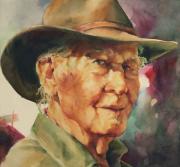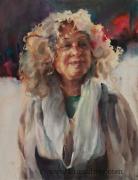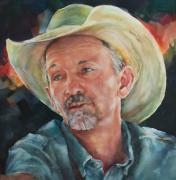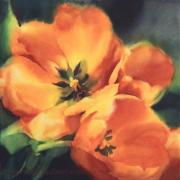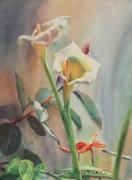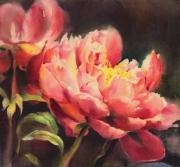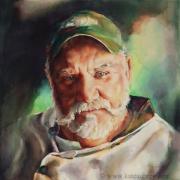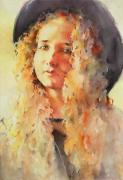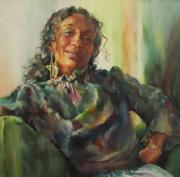Not Your Usual Color Theory
1 to 3 days - Beginner through Advanced
Kate Aubrey, Instructor
Not Your Usual Color Theory with Kate Aubrey is not your usual, dry color theory presentation. It’s a crash-course, cheat-sheet presentation full of intriguing information you can use right away. There’s a lot to discover, so it’s fast-paced. Boredom is not an option. There will be demos. There will be student experimentation. There will be answers to your questions about how Kate mixes and uses color to achieve the effects that give more impact to her work. You, too, can learn to mix gorgeous color, so come prepared to take notes and experiment!
SUPPLY LIST
- Although this color theory workshop is designed so you can use your own paints, paper, etc., I do ask that you have M. Graham’s or Stephen Quiller’s Cadmium Yellow Light. Yes, it’s important to get the exact color name by the exact maker. If you are using a medium other than watercolor, please bring all of your yellows; we might be able to find a match for my cad yellow light.
- I also require every painter have pthalocyanine blue (no other descriptors on the label) and either permanent rose or quinacridone rose on their palette.
- The paper you usually use in quarter sheets and one or two half sheets. These will be for experimentation and exercises, so backs of old paintings can work well, too.
NOTE: Cheaper papers in notebook form usually take the paint differently and are more difficult to use, nor do they show you what the paint will look and act like on your favorite paper. I discourage their use. - Please bring your usual painting setup and a nice spread of colors sufficient for quick exercises and experimentation.
If you have questions about the supplies, please call or email me and ask. This email address is being protected from spambots. You need JavaScript enabled to view it. or 775-315-0468
Because people often ask, here is a listing of my usual painting supplies and tools:
WHAT I USE
Watercolor Paints:
|
Color Name |
Brand |
|
|
+ |
Cadmium Yellow Light |
M. Graham or Quiller |
|
Permanent Orange |
Quiller |
|
|
Cadmium Red Light |
Quiller |
|
|
Cadmium Red |
M. Graham or Quiller |
|
|
+ |
Quinacridone Rose |
M. Graham |
|
Quinacridone Violet |
M. Graham |
|
|
Ultramarine Violet |
M. Graham |
|
|
Ultramarine Blue |
M. Graham |
|
|
+ |
Pthalocyanine Blue |
M. Graham |
|
Richeson Turquoise |
Quiller |
|
|
Richeson Green |
Quiller |
|
|
Permanent Green Light |
M. Graham |
|
|
Cerulean Blue |
M. Graham or Quiller |
|
|
Naples Yellow - optional |
Quiller |
+Primary colors (aka colors with Super Powers)
Quiller Traveling Palette
Watercolor Brushes:
Richeson 7000 series watermedia - carried by Jerry’s Artarama, Quiller Gallery (www.quillergallery.com) and Dick Blick (www.dickblick.com) online:
- No. 8 round
- No. 12 round
- 3/4” flat
- 1 1/2” flat
- 2” flat (for half sheet and larger)
- 3” flat (for full sheet and larger)
Watercolor paper – Hahnemuehle Cezanne (rough surface), Saunders Waterford, Arches or Fabriano Artistico, rough or cold press, 140#.
Painting setup:
- Sketch pad, 9 x 12” or 5 x 7” for design sketches/notes
- Pencils (graphite) - Prismacolor Turquoise 2B or Durwent HB or equivalent
- Pencil sharpener - small, handheld, metal
- Kneadable eraser
- Mr. Clean Original Magic Erasers
- Mabef French Backpacker’s Easel
- Board to support watercolor paper - hollow-core drafting board, plywood, masonite, Gatorboard, or other boards made for the purpose and carried by art stores and mail order art suppliers.
- Water container(s)
- Viva original paper towels
- Spray bottle - adjustable from a fine spray to a stream (Hobby Lobby)
- Hair dryer
- Plain old masking tape – 1 ½” works well, the kind made by 3M. Special tapes made for artists are OK.
- Old clothes, smock or apron
- Canon Rebel SLR digital camera or smartphone camera
- Laptop or tablet
***Please note that I will have some paints, brushes, and paper available for purchase. M.Graham and Quiller paints can often be found at or ordered by your local art supply store. You can keep them in business by looking there first.
- M. Graham and Quiller brands are carried online at www.jerrysartarama.com; you can find them by clicking on the “See All” button below the ones they list first.
- M. Graham brand is available at www.dickblick.com.
- Quiller brand paints can also be purchased at www.quillergallery.com, whose prices are sometimes less than through the above suppliers.
Painting the Floral Portrait in Watercolor
4-5 days - Kate Aubrey, Instructor
**Workshop sponsor: Please select either Option 1 OR Option 2**
Flowers are so much like people. Whether it’s the brilliant colors or the expressive “faces”, they reflect thoughts and feelings as though they could speak. Like children, flowers echo spring and shout joy and scatter themselves up the hillside. Like magicians, they gather gloom, then turn it to brightness. They heal the sick and raise up the dead to heaven. Elegant and expressive or complex and sweet, each bloom has its own traits to share. Quite simply, they beg to be painted.
Option 1 (Intermediate to Advanced students):
$5 materials fee per student for the flowers
Requires sufficient spotlighting for one floral arrangement per every two to four students, depending upon student workspace configuration. Students need to be within four feet of the setup.
Working from life, students will learn the ins and outs of painting flowers close-up in watercolor as well as how to choose and capture a specific mood through composition and value; color usage; and the balance between loose and tight, lost and found, bright and quiet. Special attention will be given to backgrounds, the mixing and application of darks/blacks, and turning “mistakes” into opportunities.
Kate’s demonstrations will include a range of techniques from tight to loose-and-drippy, as well as how to put those drips to work. Students will be encouraged to develop their own interpretation while putting new ideas and techniques to work.
Critiques will be designed to both educate and motivate.
Students should have a solid working knowledge of basic watercolor techniques.
Option 2 (Late Beginner to Advanced students):
Working from photographs (the instructor’s or theirs), students will learn the ins and outs of painting close-up flowers in watercolor as well as how to choose and capture a specific mood through composition and value; color usage; and the balance between loose and tight, lost and found, bright and quiet. Special attention will be given to the mixing and application of darks/blacks and turning “mistakes” into opportunities.
Kate’s demonstrations will include a range of techniques from tight to loose-and-drippy, as well as how to put those drips to work. Students will be encouraged to develop their own interpretation while putting new ideas and techniques to work.
Critiques will be designed to both educate and motivate.
Students should have a working knowledge of basic watercolor techniques.
Suggestions & Requirements for Photographs:
-
If painting from your own photo, please be sure what you want to paint is in focus. If you want to play with color choices, also bring a black and white print of your photo.
-
If painting from your own photo, please bring more than one the first day for the sake of choice.
-
Professionally taken photos are often lighted so shadows are minimized, making them very difficult to paint from. They are also copyrighted. For these reasons, I require that you use your own photos or a friend’s (with written permission).
-
Real photographic prints on photo paper are massively better to work from than computer printouts. CVS, Walgreens and most Costcos have easy-to-use, relatively inexpensive photo printing systems which will print regularly sized photos and enlargements from the Web, memory cards, smart phones, and tablets. They can also be ordered online and delivered to your home.
-
That said, laptops & iPads/tablets are even better to work from. Smart phones are not due to the small image. I will be working from my laptop. Special FCAC Members Note: be sure your device is fully charged. Plug outlets are very sparse at the Center.
SUPPLIES
LATE BEGINNING & EARLY INTERMEDIATE STUDENTS:
Below is a list of What I Use.
- I encourage you to use the colors I am demonstrating with if you can, as you will have a lot more success reproducing the colors and effects (and lots Less Frustration).
- Yes, it’s important to get the exact color name by the exact maker.
- If you don’t have brushes you Adore, please consider trying the Richeson 7000 brand I use. I use them because they’re really good, and that means Less Frustration, especially when you’re young at art.
- If you have questions about the supplies, please call or email me and ask. This email address is being protected from spambots. You need JavaScript enabled to view it. or 775-315-0468
LATE INTERMEDIATE & ADVANCED STUDENTS:
- Although Painting the Floral Portrait in Watercolor is designed so you can use your own paints, paper, etc., I do ask that you have M. Graham’s or Stephen Quiller’s Cadmium Yellow Light.
- Yes, it’s important to get the exact color name by the exact maker.
- Otherwise, feel free to bring all your own usual painting supplies/equipment.
Please feel free to email me with questions at This email address is being protected from spambots. You need JavaScript enabled to view it..
I will have some extra paints and supplies with me if you can’t find something ahead of time and need to buy them at the workshop. You can find M. Graham and Quiller paints online at www.jerrysartarama.com if you click on the “See All” button below the ones they list first. Prices are similar at www.dickblick.com, but they only carry the M. Graham watercolors, and you must search for them on the site in order to find them.
In addition, please check with your local art supply store first. Keeping them in business helps us all, and they can often special order the brands below if they don’t actually carry them.
WHAT I USE
(NOT Required)
Watercolor Paints:
|
Color Name |
Brand |
|
|
* |
Cadmium Yellow Light |
M. Graham or Quiller |
|
~ |
Permanent Orange |
Quiller |
|
Cadmium Red Light |
Quiller |
|
|
* |
Cadmium Red |
M. Graham or Quiller |
|
Quinacridone Rose |
M. Graham |
|
|
~ |
Quinacridone Violet |
M. Graham |
|
Ultramarine Violet |
M. Graham |
|
|
Ultramarine Blue - also good Caucasian color |
M. Graham |
|
|
* |
Pthalocyanine Blue |
M. Graham |
|
~ |
Richeson Turquoise |
Quiller |
|
Richeson Green |
Quiller |
|
|
Permanent Green Light |
M. Graham |
|
|
* |
Cerulean Blue |
M. Graham or Quiller |
|
Naples Yellow - optional |
Quiller |
* Flesh tones for Caucasians
~Flesh tones for non-Caucasians
Quiller Traveling Palette
Watercolor Brushes:
- Richeson Series 7000 Watermedia (Quiller Brushes)
- Nos. 8, 10, & 12 Rounds - good for portraiture
- 3/4”, 1 1/2”, & 2” Flats
- Carried by www.quillergallery.com and www.jerrysartarama.com online and at many local art stores across the country
- Da Vinci Maestro Rounds ( Tobolski-Kolinski sable)
- Nos. 8, 10, 12, & 14
- Carried by Art Xpress at www.artxpress.com .
- No. 8 is sold as the Mary Whyte brush
- Lovely for figure work, but pricey. Look for them on sale.
Watercolor Paper:
- Saunders Waterford, Arches, or Fabriano Artistico
- Rough or Cold Press, minimum 140#
- Hot Press 260# (Saunders Waterford)
- Hahnemuehle Cezanne (lovely rough surface, 140#)
- Due to recent unacceptable quality control issues in my old, favored brands (above), I have been experimenting with this paper and Hahnemuehle’s extremely rough surfaced Leonardo, 300#. It is a lovely, strong, properly made paper out of Germany that I have thoroughly enjoyed so far.
- If you want a smoother surface, ask Hahnemuehle or your local supplier which one to try. Specify that you want acid free, cotton rag with internal and external sizing (if available) and a minimum weight of 140#.
- I have not yet tried their hot press surface.
Painting Setup:
- Sketch pad - 2 x 12” or 5 x7” for design thumbnails & notes
- Graphite pencils - Prismacolor Turquoise 2B or Durwent HB or equivalent
- Handheld pencil sharpener
- Kneadable eraser
- Mr. Clean Original Magic Erasers
- Mabef or Richeson French Backpacker’s Easel
- Hollow-core drafting board to support watercolor paper (OR Gatorboard, etc.)
- Water containers (I use clear plastic
- Viva original paper towels
- Spray bottle - adjustable from fine spray to a stream (Hobby Lobby)
- Hair dryer
- Plain old 1 1/2” masking tape made by 3M
- Old clothes, smock or apron
- Laptop or iPad/tablet
Painting Real People in Watercolor
5 days - Kate Aubrey, Instructor
People fascinate me. Their moods, their quirks, their private loves. Their feelings large and small. These are the things I strive to capture with paint and brush. Accomplishing this depends upon what is left out at least as much as what is included. In this five day workshop, students will learn how to create a portrait that goes farther than a simple likeness. Come prepared to paint!
Day 1: Creating a Likeness
Morning: through hands-on, guided exercises and short demos, students will discover the importance of the eyes and how to render, then paint them accurately and sensitively.
Afternoon: we will continue with the nose and mouth.
Day 2: Ears, Hair and Incorporating a Background
Morning: working with Day 1’s exercises, students’ questions will be addressed. Students will also learn how to begin incorporating the background into a portrait, often as early as during the first wash.
Afternoon: through hands-on, guided exercises and short demos, students will learn how to render ears and what is needed to recreate interesting, believable hair.
Day 3: Ears, Hair, Backgrounds and Emotions - Setting the Mood
Morning: we will continue with ears, hair and background, including how to tie emotion into both subject and background.
Afternoon: Using a photographic reference (yours or mine) and demonstrations, students will lay out and begin painting a portrait that speaks. Special attention will be given to values and composition.
Days 4 & 5: Painting a Real Person - Likeness and Maintaining Mood
Using a photographic reference (yours or mine) and demonstrations, both full class and individual, students will finish laying out and then paint a portrait that speaks.
Particular attention will be given to brushwork, watercolor techniques ranging the gamut from bold and loose to tight drybrush and when to use each one for heightened emotional impact, as well as how to convey drama through values. Students will put into practice what they have learned about creating believable hair and skin tones while learning to mix harmonious darks and how and where to apply them to help build a solid composition.
PHOTOGRAPHS - Suggestions and Requirements
-
Please be sure the eyes are in focus and anything you want to paint is not blurred, especially eyes or feet if they show.
-
If bringing your own photo to work from, please bring more than one the first day for the sake of choice.
-
Unless you are already an experienced portrait artist, I strongly recommend painting someone you do not know well during the workshop. So does Ted Nuttall. There are important reasons for this.
-
When painting people, shadows are good. Professionally taken photos are lighted so no shadows fall on the subject’s face. This makes them very difficult to paint from, so avoid school photos or magazine-type photos.
-
Teeth are very hard to paint. Please use an unsmiling model unless you are a very experienced portraitist.
-
Real photographic prints on photo paper are massively better to work from than computer printouts. CVS, Walgreens and most Costcos have easy-to-use, relatively inexpensive photo printing systems which will print regularly sized photos and enlargements from the Web, memory cards, smart phones, and tablets. They can also be ordered online and delivered to your home.
-
However, laptops and tablets are even better to work from. Smart phones are not due to the smallness of the image. I will be working from my laptop. Be sure your device is fully charged each day, as outlets are sometimes hard to come by.
SUPPLIES
For the most part, please feel free to use your own colors, brushes, palette, etc. if you wish. I have included a list of what I use for your information, NOT as a required supply list.
That said, please be sure to have the cadmium yellow light by M. Graham or Stephen Quiller Watercolors. Other brands are different colors entirely. Hansa yellow or aureolin may be substituted, but have drawbacks. Hansa yellow, in particular, should be used only if nothing else is available. Please feel free to email me with questions at This email address is being protected from spambots. You need JavaScript enabled to view it..
Flesh tone colors are marked in the list of “What I Use” below. I often add others, but for basic, believable flesh tones, those marked are excellent. Colors for Cauasian tones are marked with an asterisk. Colors for non-Caucasian tones are marked with a tilda.
I will have some extra paints and supplies with me if you can’t find something ahead of time and need to buy them at the workshop.
You can find M. Graham and Quiller paints online at www.jerrysartarama.com if you click on the “See All” button below the ones they list first. Prices are similar at www.dickblick.com, but they only carry the M. Graham watercolors, and you must search for them on the site in order to find them.
And please, check with your local art supply store first when you can. Keeping them in business helps us all, and they can often special order the brands below if they don’t actually carry them.
WHAT I USE
(NOT Required)
Watercolor Paints:
|
Color Name |
Brand |
|
|
* |
Cadmium Yellow Light |
M. Graham or Quiller |
|
~ |
Permanent Orange |
Quiller |
|
Cadmium Red Light |
Quiller |
|
|
* |
Cadmium Red |
M. Graham or Quiller |
|
Quinacridone Rose |
M. Graham |
|
|
~ |
Quinacridone Violet |
M. Graham |
|
Ultramarine Violet |
M. Graham |
|
|
Ultramarine Blue - also good Caucasian color |
M. Graham |
|
|
* |
Pthalocyanine Blue |
M. Graham |
|
~ |
Richeson Turquoise |
Quiller |
|
Richeson Green |
Quiller |
|
|
Permanent Green Light |
M. Graham |
|
|
* |
Cerulean Blue |
M. Graham or Quiller |
|
Naples Yellow - optional |
Quiller |
* Flesh tones for Caucasians
~ Flesh tones for non-Caucasians
Quiller Traveling Palette
Watercolor Brushes:
- Richeson Series 7000 Watermedia (Quiller Brushes)
- Nos. 8, 10, & 12 Rounds - good for portraiture
- 3/4”, 1 1/2”, & 2” Flats
- Carried by www.quillergallery.com and www.jerrysartarama.com online and at many local art stores across the country
- Da Vinci Maestro Rounds ( Tobolski-Kolinski sable)
- Nos. 8, 10, 12, & 14
- Carried by Art Xpress at www.artxpress.com .
- No. 8 is sold as the Mary Whyte brush
- Lovely for figure work, but pricey. Look for them on sale.
Watercolor Paper:
- Saunders Waterford, Arches, or Fabriano Artistico
- Rough or Cold Press, minimum 140#
- Hot Press 260# (Saunders Waterford)
- Hahnemuehle Cezanne (lovely rough surface, 140#)
- Due to recent unacceptable quality control issues in my old, favored brands (above), I have been experimenting with this paper and Hahnemuehle’s extremely rough surfaced Leonardo, 300#. It is a lovely, strong, properly made paper out of Germany that I have thoroughly enjoyed so far.
- If you want a smoother surface, ask Hahnemuehle or your local supplier which one to try. Specify that you want acid free, cotton rag with internal and external sizing (if available) and a minimum weight of 140#.
- I have not yet tried their hot press surface.
Painting Setup:
- Sketch pad - 2 x 12” or 5 x7” for design thumbnails & notes
- Graphite pencils - Prismacolor Turquoise 2B or Durwent HB or equivalent
- Handheld pencil sharpener
- Kneadable eraser
- Mr. Clean Original Magic Erasers
- Mabef or Richeson French Backpacker’s Easel
- Hollow-core drafting board to support watercolor paper (OR Gatorboard, etc.)
- Water containers (I use clear plastic
- Viva original paper towels
- Spray bottle - adjustable from fine spray to a stream (Hobby Lobby)
- Hair dryer
- Plain old 1 1/2” masking tape made by 3M
- Old clothes, smock or apron
- Laptop or iPad/tablet

